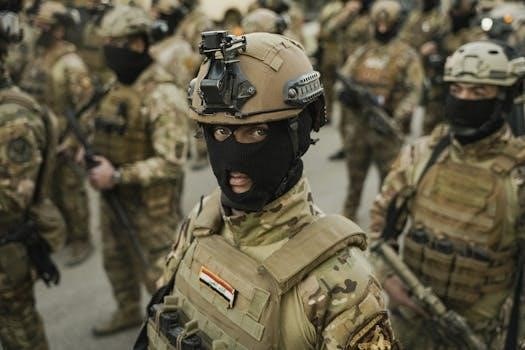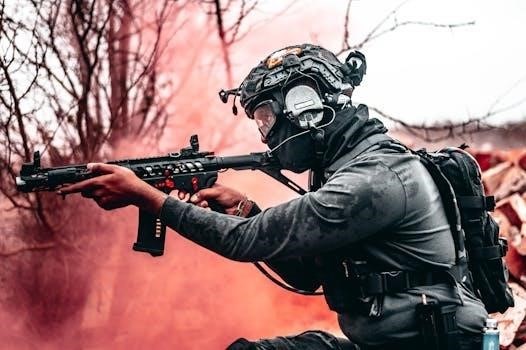This is My Squad (TIMS) Initiative⁚ An Overview
The “This Is My Squad” (TIMS) initiative, championed by the Sergeant Major of the Army, aims to foster a stronger sense of belonging and cohesion within Army units. TIMS seeks to empower squad leaders to build disciplined, positive, and ready teams, mitigating issues like suicide and harassment.

The Core Concept of “This Is My Squad”
The core concept of “This Is My Squad” (TIMS) revolves around fostering a strong sense of ownership and responsibility at the squad level. It emphasizes the importance of interpersonal connections between leaders and soldiers, allowing leaders to better understand and manage their team members based on individual strengths. TIMS aims to cultivate a close-knit squad culture characterized by pride, discipline, and mutual protection.
At its heart, TIMS is a leadership philosophy designed to create a positive and supportive environment where soldiers feel valued and connected. This initiative encourages leaders to proactively engage with their soldiers, address their concerns, and build trust. By instilling a sense of belonging and shared purpose, TIMS seeks to improve unit cohesion, morale, and overall readiness.
The overarching theme of TIMS is ownership, which involves leaders taking responsibility for the well-being and development of their soldiers. This includes active listening, mentorship, and creating opportunities for soldiers to grow both personally and professionally. The ultimate goal is to transform the Army culture by empowering leaders at all levels to communicate effectively, foster a sense of belonging, and institute positive change within their squads.
SMA Grinston’s Vision for Unit Cohesion
Sergeant Major of the Army (SMA) Michael Grinston’s vision for unit cohesion centers on building strong, interconnected teams where every soldier feels valued and supported. He emphasizes the critical role of squad leaders in fostering this environment, encouraging them to get to know their soldiers on a personal level and understand their individual needs and strengths. Grinston believes that cohesive units are more resilient, adaptable, and effective in accomplishing their missions.
His vision is deeply rooted in the idea that strong unit cohesion directly contributes to improved soldier well-being and overall readiness. By creating a culture of trust and mutual respect, Grinston aims to mitigate issues such as suicide, sexual harassment, and low morale, which can negatively impact unit performance. He champions the “This Is My Squad” initiative as a means to instill a specific mindset in soldiers, particularly squad leaders, fostering a sense of responsibility and care for their team members.
Grinston’s vision extends to empowering non-commissioned officers (NCOs) with the necessary leadership skills to build and maintain cohesive units. He advocates for continuous leader development and mentorship programs that equip squad leaders with the tools and knowledge to effectively lead and support their soldiers, ultimately strengthening the entire Army force.
Key Objectives of the TIMS Initiative
The “This Is My Squad” (TIMS) initiative has several key objectives all focused on bolstering the strength and effectiveness of the U.S. Army. A primary aim is to foster a sense of belonging and pride among soldiers, creating a close-knit squad culture where individuals feel valued and supported. This involves encouraging leaders at all levels to communicate effectively, empower their subordinates, and institute changes that transform the Army culture.
Another crucial objective is to improve team cohesion by emphasizing ownership and responsibility at the squad level. TIMS seeks to build strong, cohesive teams by encouraging leaders to get to know their soldiers personally and understand their strengths and weaknesses. This interpersonal connection is vital for creating a positive environment where soldiers can accomplish missions together effectively.
Furthermore, TIMS aims to reduce negative behaviors and incidents within the Army, such as sexual harassment, sexual assault, suicide, and racism. By fostering a culture of respect, trust, and open communication, the initiative seeks to address these critical issues proactively. Ultimately, TIMS aims to create a more resilient and effective Army by empowering squad leaders and fostering strong unit cohesion.
The Squad Leader’s Role in TIMS
Squad leaders are crucial to TIMS, building cohesive units and fostering pride and discipline. They lead by example, knowing their soldiers, and employing evidence-based leadership. This creates a positive environment to accomplish missions effectively and address issues early on.
Empowering Squad Leaders Through Leadership Skills
The Army Resilience Directorate supports TIMS through the Squad Leader Development Course (SLDC). This course equips squad leaders with evidence-based leadership skills, improving unit cohesion and resilience. SLDC encourages critical reflection on personal leadership styles and promotes ethical leadership behaviors outlined in Army doctrine;
SLDC facilitators guide leaders to craft a leadership philosophy focused on commitment, trust, and development. This philosophy increases leader consistency and provides a plan for value-based action, helpful in challenging situations.
Sharing this philosophy improves relationships by clarifying values, priorities, and expectations. The course involves discussions on doctrine and research from human performance, organizational psychology, and positive psychology, emphasizing the impact of squad-level leadership behaviors. The goal is to motivate leaders to adopt and internalize effective behaviors, fostering strong and resilient units capable of facing any challenge. Ultimately, empowered squad leaders are the key to TIMS’ success.

Addressing Critical Issues Through TIMS
TIMS aims to create cohesive units, potentially decreasing instances of sexual harassment, assault, suicide, and racism. By fostering a close-knit squad culture, TIMS promotes pride, discipline, and mutual protection among Soldiers, addressing critical issues within the Army.
Combating Suicide, Sexual Harassment, and Morale Issues
The “This Is My Squad” (TIMS) initiative directly confronts critical issues impacting Army readiness and Soldier well-being. Suicide prevention, sexual harassment and assault reduction, and overall morale improvement are key objectives. By fostering stronger unit cohesion and empowering squad leaders, TIMS seeks to create a more supportive and respectful environment.
A cohesive squad, built on trust and mutual respect, can serve as a vital support network for Soldiers facing personal challenges. Squad leaders, equipped with enhanced leadership skills and a deeper understanding of their Soldiers’ needs, are better positioned to identify at-risk individuals and intervene effectively.
TIMS promotes open communication and encourages Soldiers to seek help when needed, reducing the stigma associated with mental health issues and reporting incidents of harassment or assault. The initiative aims to cultivate a culture where Soldiers feel safe, valued, and connected to their unit, ultimately contributing to a more resilient and mission-ready force. Furthermore, the initiative aims to decrease alcohol and safety incidents.

The Squad Leader Development Course (SLDC)
The Squad Leader Development Course (SLDC) is the Army Resilience Directorate’s contribution to TIMS. It provides squad leaders with critical reflection opportunities on their leadership styles and evidence-based leadership skills to foster unit cohesion.
Course Content⁚ Commitment, Trust, and Development
SLDC facilitators guide squad leaders in crafting their personal leadership philosophy, emphasizing commitment, trust, and development. This philosophy promotes consistency and effectiveness, providing a framework for value-based action, especially in challenging situations. Sharing this philosophy enhances relationships by clarifying values, priorities, and expectations.
The two-day course explores Army Doctrine Publication 6-22 and research from human performance, organizational, and positive psychology. It highlights squad-level leadership behaviors, discussing character, motivation, and trust. The goal is to motivate leaders to internalize doctrinal and research-supported behaviors.
A pilot SLDC, delivered to squad leaders on Grinston’s TIMS Leadership Panel, gathered feedback for improvement. The course aims to equip squad leaders with tools to build cohesive and resilient units.
Evaluating the Effectiveness of SLDC
To gauge the Squad Leader Development Course’s impact, the Walter Reed Army Institute of Research is conducting a longitudinal evaluation. This assessment aims to determine if the training enhances squad leader knowledge, attitudes, and behaviors conducive to unit trust and ethical leadership.
In collaboration with R2 Performance Experts at Fort Riley, SLDC will be delivered to squad leaders within the 1st Infantry Division. A randomized approach will see half receive immediate training, while the other half serves as a control group, receiving training post-evaluation.
Participants complete surveys before, after, and two months following training; These surveys assess pre-training knowledge, attitudes, and behaviors, and provide feedback on the course. The evaluation seeks to quantify SLDC’s success in fostering cohesive, resilient Army units through improved squad leader capabilities and ethical conduct.

Implementing TIMS⁚ Challenges and Experiences
Implementing the “This Is My Squad” initiative presents both opportunities and challenges. Company-level leaders are at the forefront, translating the vision into tangible actions. They navigate diverse personalities, experiences, and expectations within their squads. A key challenge lies in fostering genuine connection and trust amidst operational demands.
Some leaders find success by prioritizing regular communication, actively listening to their soldiers, and demonstrating empathy. Others struggle with balancing mission requirements with individual needs. Overcoming resistance to change and ensuring consistent application of TIMS principles across the force remain ongoing efforts. Sharing experiences and best practices becomes crucial for refining implementation strategies.
Sustaining the momentum of TIMS requires continuous reinforcement from leadership at all levels. The Army seeks to learn from both successes and setbacks, adapting the initiative to better serve its soldiers and build stronger, more cohesive units.